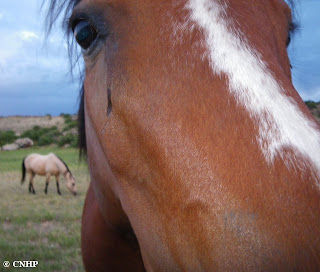Although our field crews are prepared to work in all kinds of conditions, field work frequently includes an element of the unexpected. Live-trapping is an important aspect of zoology field work. While live-traps come in various sizes and configurations, it is impossible to ensure that only the species you are interested in wander into them. Zoologists trapping for small to mid-sized mammals therefore never know what they might find.
Some days are more exciting than others.
Old broom handles come in handy for remote trap door release, though it isn't nearly remote enough.
"Rare squirrel species? Sorry, haven't seen it [urp]."
Botany is usually not as heart-poundingly exciting, but does require an intimate knowledge of itty-bitty plant parts, and high-powered lenses.
...and we do mean itty bitty.
A number of CNHP staff practice yoga. This is known as the Downward Botanist.
While there are botanical aspects to wetland classification and quality assessment, this type of field work also involves a serious appreciation for the finer points of mud.
That there is some good mud, I tell you what.
I think the soil pit is winning, Joanna.
We always get landowner permission before accessing a property. Locals are often gratifyingly interested in our work.
It can be a bit tough on the toes, though (whoa, there).
Posting frequency here at the ol' CNHP Blog may get a little irregular over the next few months as we go out and get more valuable data on the biodiversity and ecological health of our great state (and those of us left in the office get a chance to catch up on work that's been piling up), but keep checking in over the summer as we still have a lot more to say. As always, thanks for reading!










No comments:
Post a Comment
Thanks for your comment!
Please note that all comments are moderated, so there may be a delay of some hours (especially over the weekend or at night Colorado time) before your comment shows up.